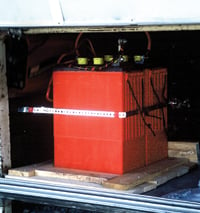
While the price of lead isn’t skyrocketing, the prices of batteries made with this heavy metal are anything but light. Buying just one RV battery will require more than a hundred dollar bill, and if you’re buying name-brand six-volt batteries, it can blast a couple of them in short order. But until we have to pass cash across the counter to replace a bum battery, we don’t think much about those mysterious black boxes. We should. After all, a little bit of battery maintenance can save a lot of money.
Before we get into the details, the usual word of caution: Whenever you work with batteries or electrical systems, even low voltage ones, take off your jewelry! Watches, rings, and bling-bling things. The potential energy in an RV battery is something to reckon with, and welding your ring to an electrical contact will ruin your whole day. Watch out with tools and other metals. The male of this writing duo once dropped a crescent wrench across a deep-cycle battery—fortunately he was able to rescue it before it welded into place, narrowly avoiding a major fire.
Maintenance Minders
When your RV is “in storage,” and not in harness on the open road, don’t neglect the battery. A depleted battery not kept at full charge is one that can more easily freeze. If it does, you can expect the expansion to crack the case and ruin the battery. A simple maintenance charger that “floats” at full charge isn’t costly, and will save big money.
Power consumption while your rig is in storage can create problems, too. Yes, you shut everything off, but there are loads that you may not have thought of. LP gas and carbon monoxide detectors that are hard-wired to the 12-volt system never shut off. One way to deal with this is to either disconnect the battery leads when not using the rig, or by pulling the fuse that sends power to these detectors. If you choose the latter route, put a BIG sign up in the rig, reminding yourself to plug the fuse back in before heading out on the road. And when you pull that fuse, shut off the LP supply valve for a little more peace of mind.
While you don’t need to be compulsive about it, keeping your batteries clean will keep them happier. That little bit of dirt across the top of the battery case can actually conduct electricity in the presence of moisture. A slight, but real, discharge of juice can occur. And keep those terminals clean—a little crud, corruption or corrosion will impede the flow of those healthy electrons, and can lead to problems.
Fill ‘er up! ALWAYS keep the top plates of “flooded” batteries covered with electrolyte. This means refilling to the “split ring” or about a half-inch above the separators. ONLY USE distilled water, NEVER tap water. Minerals in tap water can cause real issues for batteries. On the other hand, don’t over-fill your cells.
No Miracles
Pass on the additives. Don’t add “battery acid” or other additives. Thus far nothing has really proved up in the way of a miracle elixir that will give you more power, more potency, or more life to your batteries. There’s no such thing as Voltage Viagra.
Keeping batteries filled, particularly ones in tight spaces, can be challenging. Our fifth wheel had very little “head space” in the compartment above the top of the batteries, and the batteries didn’t easily come out for service. A solar panel retailer sold us a battery fill tool, a hollow “fill it with water” handle made out of plastic pipe, connected to the “filler part” that presses into the battery cell and fills until the correct level is reached. We haven’t found any on the web, but RVers tell us some RV solar outfits sell them.
If you’re stuck with a similar situation and can’t find something that will slide into the narrow space above your batteries, here’s a variation that might work. Get a rubber bulb battery filler from an auto parts store, and attach a length of appropriate size plastic tubing that fits firmly onto the filler tube. It’s not “automatic,” but coupled with an assistant equipped with a hand-mirror, you may be able to make that work. Other options include automatic RV battery water systems. These can be spendy, over $100, but if they save you the cost of replacing a battery or two, it may be well worth the investment.
Russ and Tiña De Maris are authors of RV Boondocking Basics—A Guide to Living Without Hookups, which covers a full range of dry camping topics. Visit icanrv.com for more information.

I have been RVing for 15 years. I’m currently on my second RV (2013 ACE).
I have always used two 6 volt golf batteries in series, a much better set up than two 12 VDC batteries wired in parallel.
What are your thoughts on converting to a group size 8D? This is a really large battery and it will easily fit in my RV. We boondock many times and I was thinking the extra capacity of an 8D would require less charging with my gen-set.
Thanks
Eugene Eckis